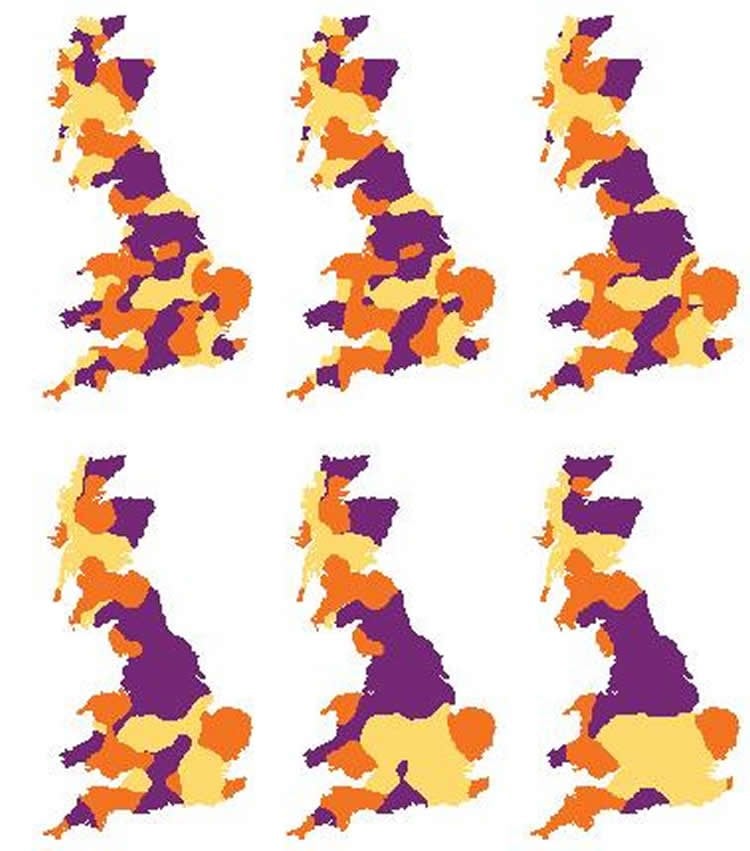Summary: A new study reveals dialects move outwards from population centers, which may explain why some cities have their own dialects, researchers say.
Source: University of Portsmouth.
Language patterns could be predicted by simple laws of physics, a new study has found.
Dr James Burridge from the University of Portsmouth has published a theory using ideas from physics to predict where and how dialects occur.
He said: “If you want to know where you’ll find dialects and why, a lot can be predicted from the physics of bubbles and our tendency to copy others around us.
“Copying causes large dialect regions where one way of speaking dominates. Where dialect regions meet, you get surface tension. Surface tension causes oil and water to separate out into layers, and also causes small bubbles in a bubble bath to merge into bigger ones.
“The bubbles in the bath are like groups of people – they merge into the bigger bubbles because they want to fit in with their neighbours.
“When people speak and listen to each other, they have a tendency to conform to the patterns of speech they hear others using, and therefore align their dialects. Since people typically remain geographically local in their everyday lives, they tend to align with those nearby.”
Dr Burridge from the University’s department of mathematics departs from the existing approaches in studying dialects to formulate a theory of how country shape and population distribution play an important role in how dialect regions evolve.
Traditional dialectologists use the term ‘isogloss’ to describe a line on a map marking an area which has a distinct linguistic feature.
Dr Burridge said: “These isoglosses are like the edges of bubbles – the maths used to describe bubbles can also describe dialects.

“My model shows that dialects tend to move outwards from population centres, which explains why cities have their own dialects. Big cities like London and Birmingham are pushing on the walls of their own bubbles.
“This is why many dialects have a big city at their heart – the bigger the city, the greater this effect. It’s also why new ways of speaking often spread outwards from a large urban centre.
“If people live near a town or city, we assume they experience more frequent interactions with people from the city than with those living outside it, simply because there are more city dwellers to interact with.
His model also shows that language boundaries get smoother and straighter over time, which stabilises dialects.
Dr Burridge’s research is driven by a long-held interest in spatial patterns and the idea that humans and animal behaviour can evolve predictably. His research has been funded by the Leverhulme Trust.
Source: Phil Roth – University of Portsmouth
Image Source: NeuroscienceNews.com image is credited to James Burridge, University of Portsmouth.
Original Research: Abstract for “Spatial Evolution of Human Dialects” by James Burridge in Physical Review X. Published online July 17 doi:10.1103/PhysRevX.7.031008
[cbtabs][cbtab title=”MLA”]University of Portsmouth “Physics of Bubbles May Explain Language Patterns.” NeuroscienceNews. NeuroscienceNews, 24 July 2017.
<https://neurosciencenews.com/language-bubble-physics-7168/>.[/cbtab][cbtab title=”APA”]University of Portsmouth (2017, July 24). Physics of Bubbles May Explain Language Patterns. NeuroscienceNew. Retrieved July 24, 2017 from https://neurosciencenews.com/language-bubble-physics-7168/[/cbtab][cbtab title=”Chicago”]University of Portsmouth “Physics of Bubbles May Explain Language Patterns.” https://neurosciencenews.com/language-bubble-physics-7168/ (accessed July 24, 2017).[/cbtab][/cbtabs]
Abstract
Spatial Evolution of Human Dialects
The geographical pattern of human dialects is a result of history. Here, we formulate a simple spatial model of language change which shows that the final result of this historical evolution may, to some extent, be predictable. The model shows that the boundaries of language dialect regions are controlled by a length minimizing effect analogous to surface tension, mediated by variations in population density which can induce curvature, and by the shape of coastline or similar borders. The predictability of dialect regions arises because these effects will drive many complex, randomized early states toward one of a smaller number of stable final configurations. The model is able to reproduce observations and predictions of dialectologists. These include dialect continua, isogloss bundling, fanning, the wavelike spread of dialect features from cities, and the impact of human movement on the number of dialects that an area can support. The model also provides an analytical form for Séguy’s curve giving the relationship between geographical and linguistic distance, and a generalization of the curve to account for the presence of a population center. A simple modification allows us to analytically characterize the variation of language use by age in an area undergoing linguistic change.
“Spatial Evolution of Human Dialects” by James Burridge in Physical Review X. Published online July 17 doi:10.1103/PhysRevX.7.031008






